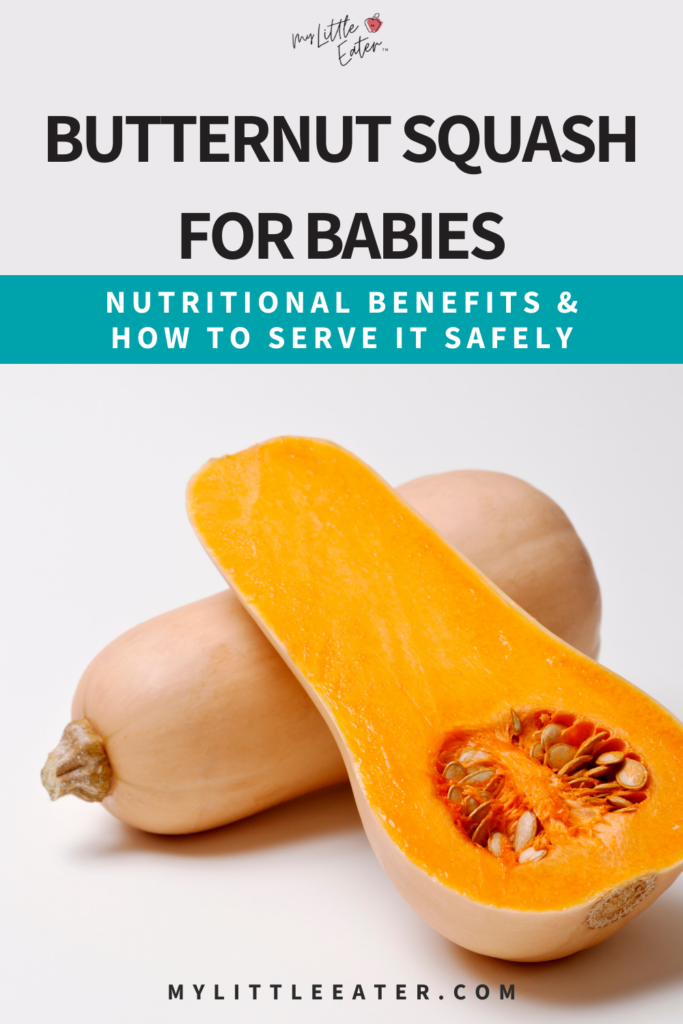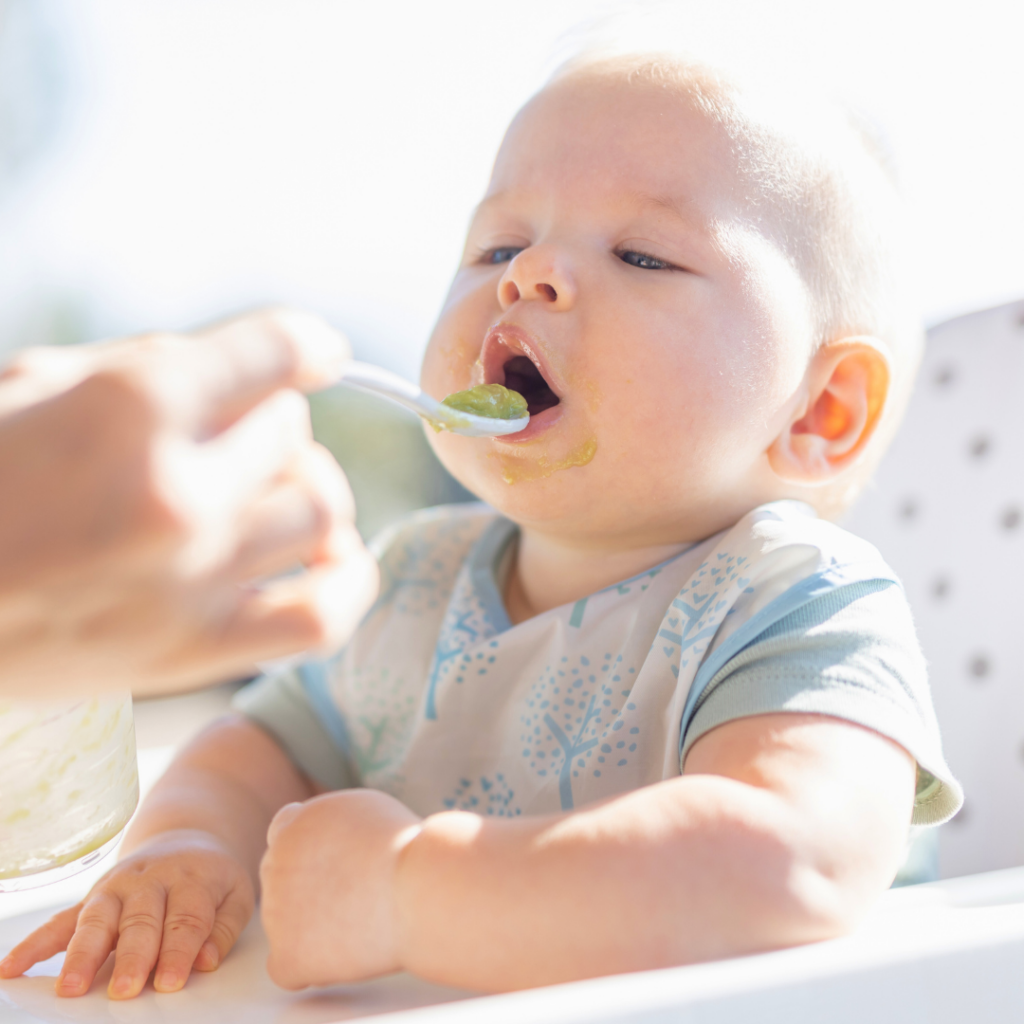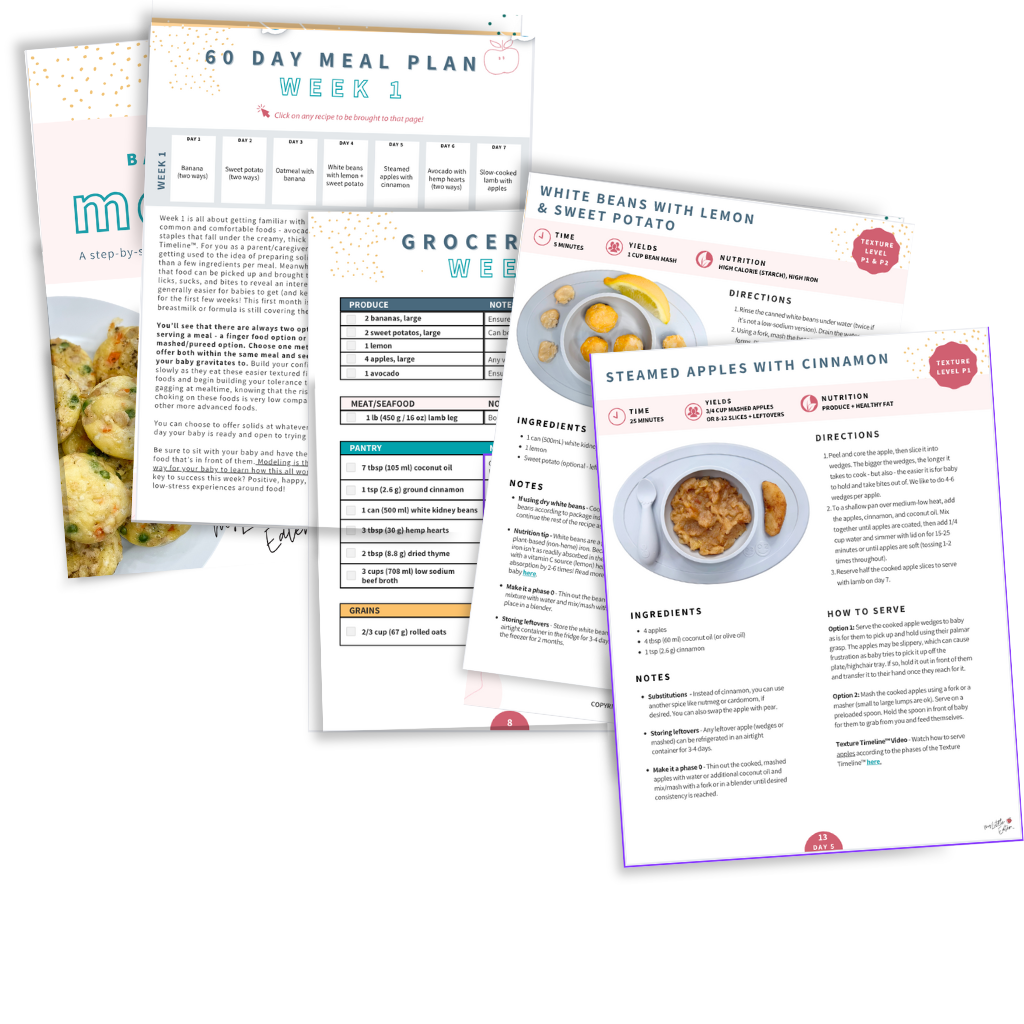This post may contain affiliate links, please view our disclosure policy for more details.
Butternut squash is naturally sweet and has a soft, creamy (sometimes slightly stringy) texture when cooked to the right degree.
It can be mashed up, pureed, or roasted to be served as a finger food, making it the perfect food to ease into solids with. Use it to watch your baby transition through the phases of the Texture Timeline™ – developing new skills along the way.
Table of Contents
When can babies eat butternut squash?
Babies can eat butternut squash as soon as they start solids at around 6 months of age when they’re showing all of the developmental signs of readiness. It could even be your baby’s first food if you’d like!
How to serve butternut squash according to the Texture Timeline™
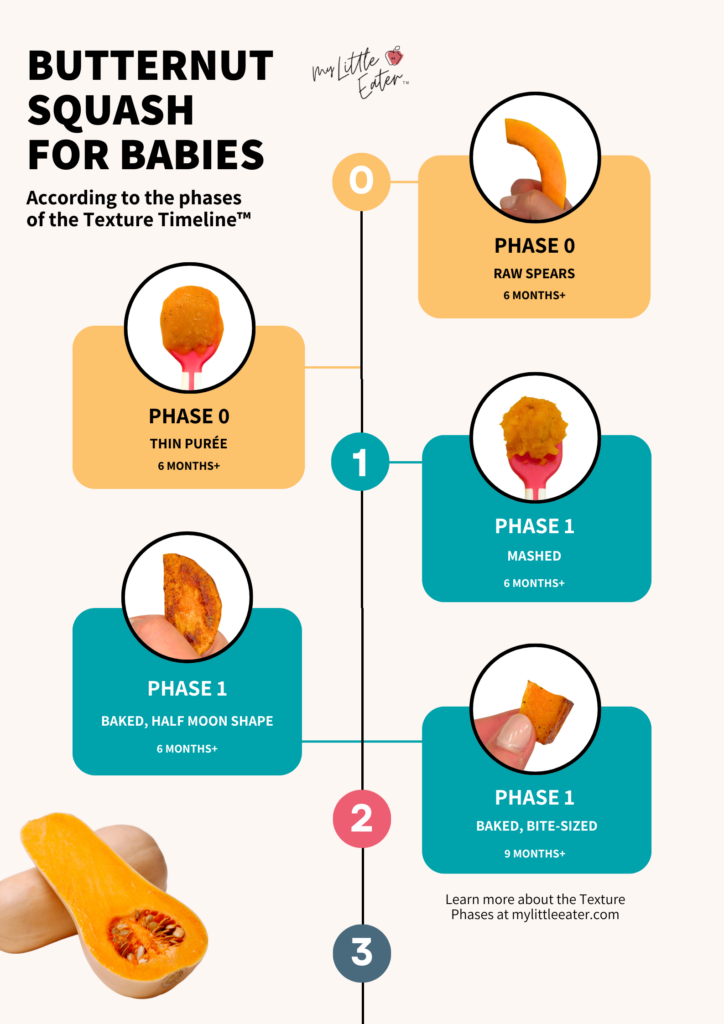
These are the safest, suggested ways to serve food to your baby based on the scientific, developmental, and clinical research and expertise available to date and are vetted by pediatric doctors, speech-language pathologists, and dietitians. However, please note that babies can technically choke on anything, including purees. Always take into account your child’s individual abilities and needs and check with your doctor or feeding therapist on the safety of offering these foods to your baby. Be mindful of how to set up a safe eating environment and please know that all material, opinions, advice, and information found on mylittleeater.com is for informational and educational purposes only. See our disclaimer for more information.
What is the Texture Timeline™?
A tool exclusive to My Little Eater that allows you to start solids with your baby using purées, finger foods, or a mixture of both. We sort all foods into different phases of the timeline based on texture difficulty, presenting multiple ways to serve each food depending on what you and your baby are ready for.
You can start with any phase of the Texture Timeline™. The goal is to always be moving forward on the timeline so that you can advance your baby to more challenging textures in a timely manner. This will allow your baby to develop and practice new eating skills and ensure that they don’t stay stuck on one texture for too long.
Using the Texture Timeline™ can help to prevent picky eating, all while keeping the feeding process enjoyable and less stressful for you because you can ease into the difficult textures that often cause more anxiety and worry.
Always thoroughly wash produce before cutting it. Even though you won’t be eating the outside of this particular food, when you cut through the skin, bacteria can be transferred to the inner portion of the squash.
You can clean it by rinsing it underwater and gently rubbing the skin with your hands to remove any residue.
Texture Timeline™ Phase 1
Mashed (Utensils)
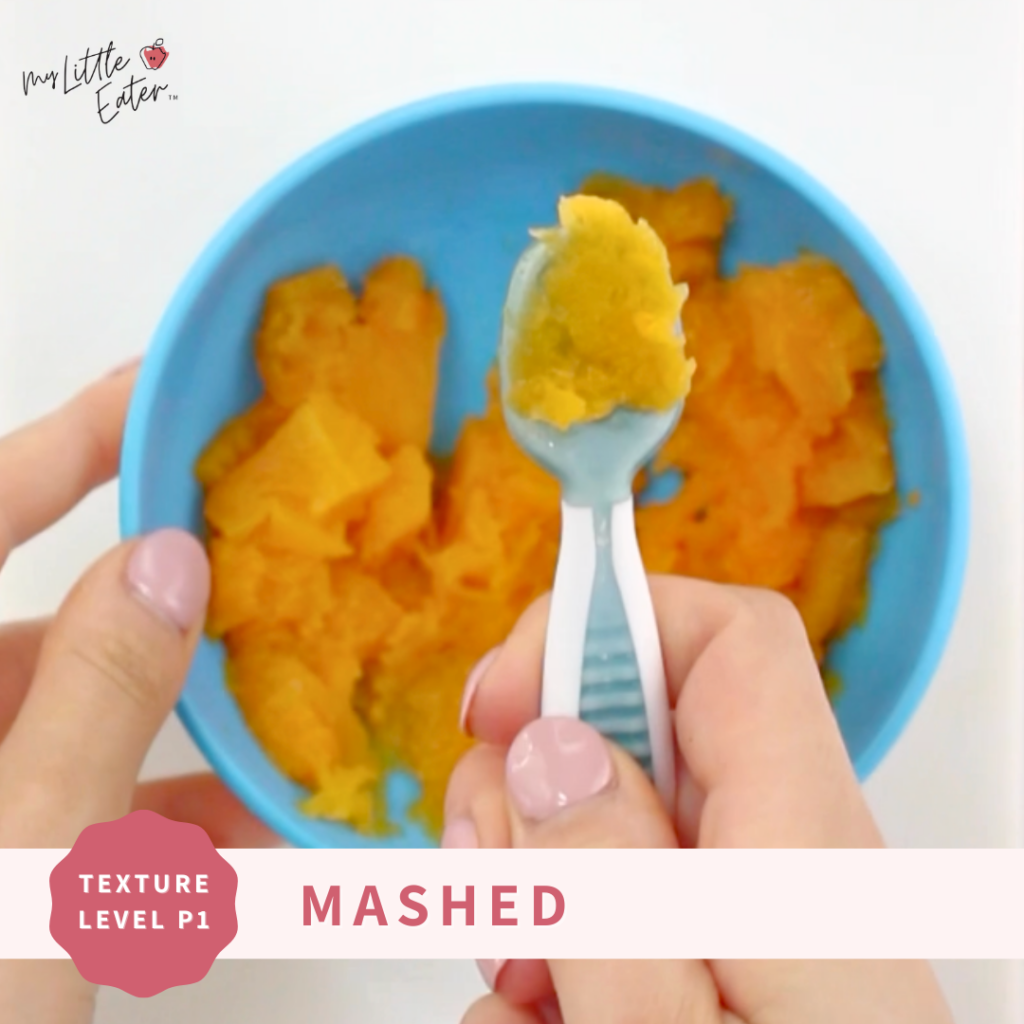
Step 1: Place the washed butternut squash on a cutting board. Begin by slicing off both ends of the butternut squash and removing the skin.
Step 2: Slice the butternut squash in half horizontally. Slice both halves vertically down the center. Using a spoon, scoop out the seeds and stringy parts in the center of each of the 4 individual pieces.
Step 3: Place the butternut squash on a lined sheet pan. Roast for approximately 50 minutes at 400°F or until soft and easy to mash with your fingers.
Step 4: Mash the butternut squash with a fork and serve to your baby on a preloaded spoon for them to self-feed, or you can spoon-feed it to them. You can also give them a small bowl of mashed squash and let them get messy by self-feeding with their hands.
Phase 1 is a step up from thin purees, meaning that some lumps and bumps in the butternut squash puree are what we’re looking for. So don’t aim to get a perfectly smooth texture when mashing up the squash.
However, if you don’t feel ready for that, you can also offer it as a phase 0. Make a thin butternut squash puree by adding some breastmilk or formula to the squash and blending until smooth.
Texture Timeline™ Phase 1
Half-moon shape (Palmar Grasp)

Step 1: Place the washed butternut squash on a cutting board. Begin by slicing off both ends of the butternut squash and removing the skin.
Step 2: Slice the butternut squash in half horizontally. Slice both halves vertically down the center. Using a spoon, scoop out the seeds and stringy parts in the center of each of the 4 individual pieces.
Step 3: Slice each of the 4 pieces into half-moon shapes/wedges, approximately 1 inch thick.
Step 4: Place the butternut squash on a lined sheet pan. Roast for approximately 35 minutes at 400°F or until it’s a soft enough consistency while still keeping its shape.
Pro Tip: Use the squish test to determine if the half moons have cooked for long enough. Remove one piece from the pan to allow it to cool, then pick it up and gently apply pressure to it between your thumb and forefinger. If it squishes, then it’s soft enough for your baby’s gums to mash as well!
Texture Timeline™ Phase 1
Diced (Pincer Grasp)
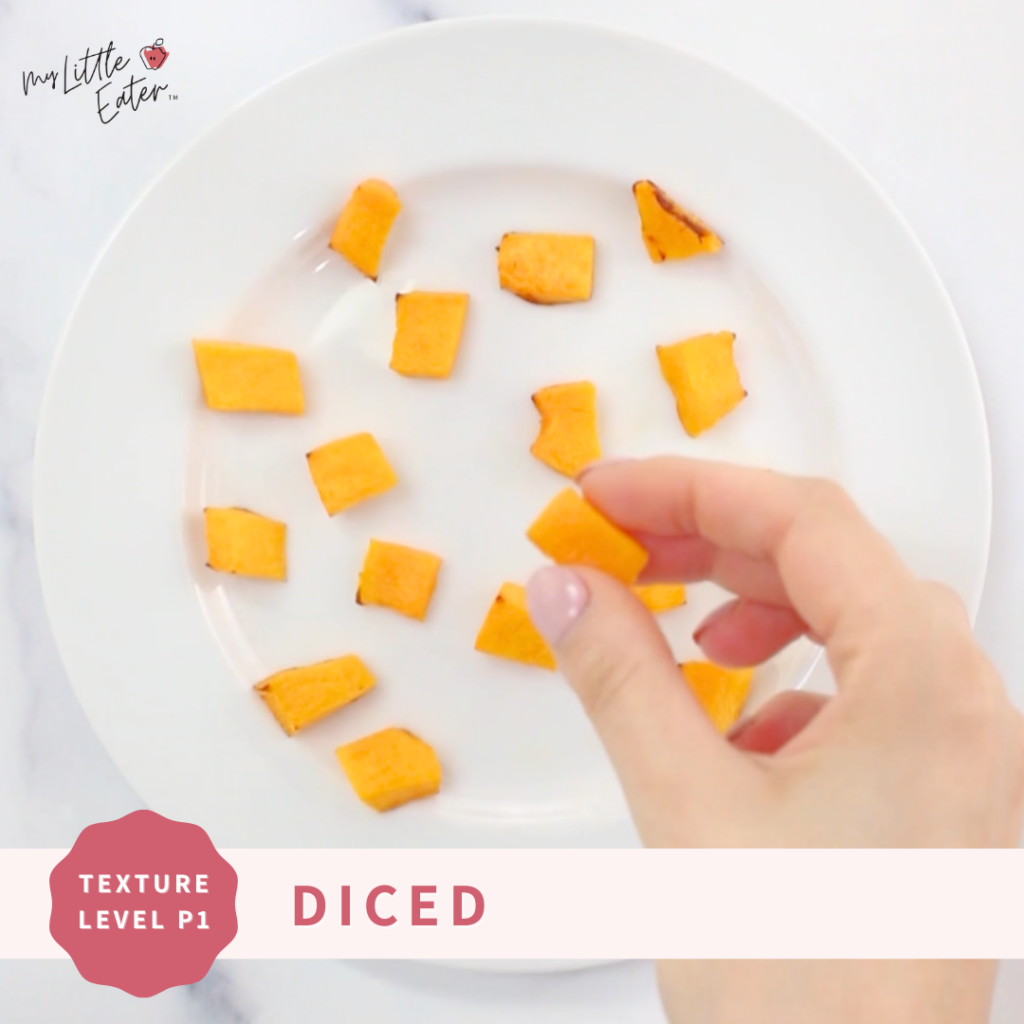
Step 1: Place the washed butternut squash on a cutting board. Begin by slicing off both ends of the butternut squash and removing the skin.
Step 2: Slice the butternut squash in half horizontally. Slice both halves vertically down the center. Using a spoon, scoop out the seeds and stringy parts in the center of each of the 4 individual pieces.
Step 3: Cut the butternut squash into small diced pieces (½ to 1 inch in size) for your baby to eat with their pincer grasp.
Step 4: Place the butternut squash on a lined sheet pan. Roast for approximately 25 minutes at 400°F or until soft.
Avoid offering this shape until your baby has begun to develop their pincer grasp, typically around 9 months of age. Then, once your baby has developed their pincer grasp, continue to offer larger shapes from time to time for biting practice.
Watch Rory & Brinley eat butternut squash!
Watch Rory & Brinley eat butternut squash!
Rory is around 5.5 months old and is eating butternut squash for the first time! They’re having it mashed on a preloaded spoon, as well as served roasted as a finger food.
Brinley is 7.5 months old and eating butternut squash using their palmar grasp.
Is butternut squash a choking hazard for babies?
No, it’s not a common choking hazard for babies as long as it has been cooked down to a soft texture.
Always make sure you’re offering your baby appropriate foods based on their skill level and ability to chew their food thoroughly.
How to pick a ripe butternut squash
With produce like squash where you can’t actually see the part that you’re eating, it can be difficult to know how to tell if they’re ripe.
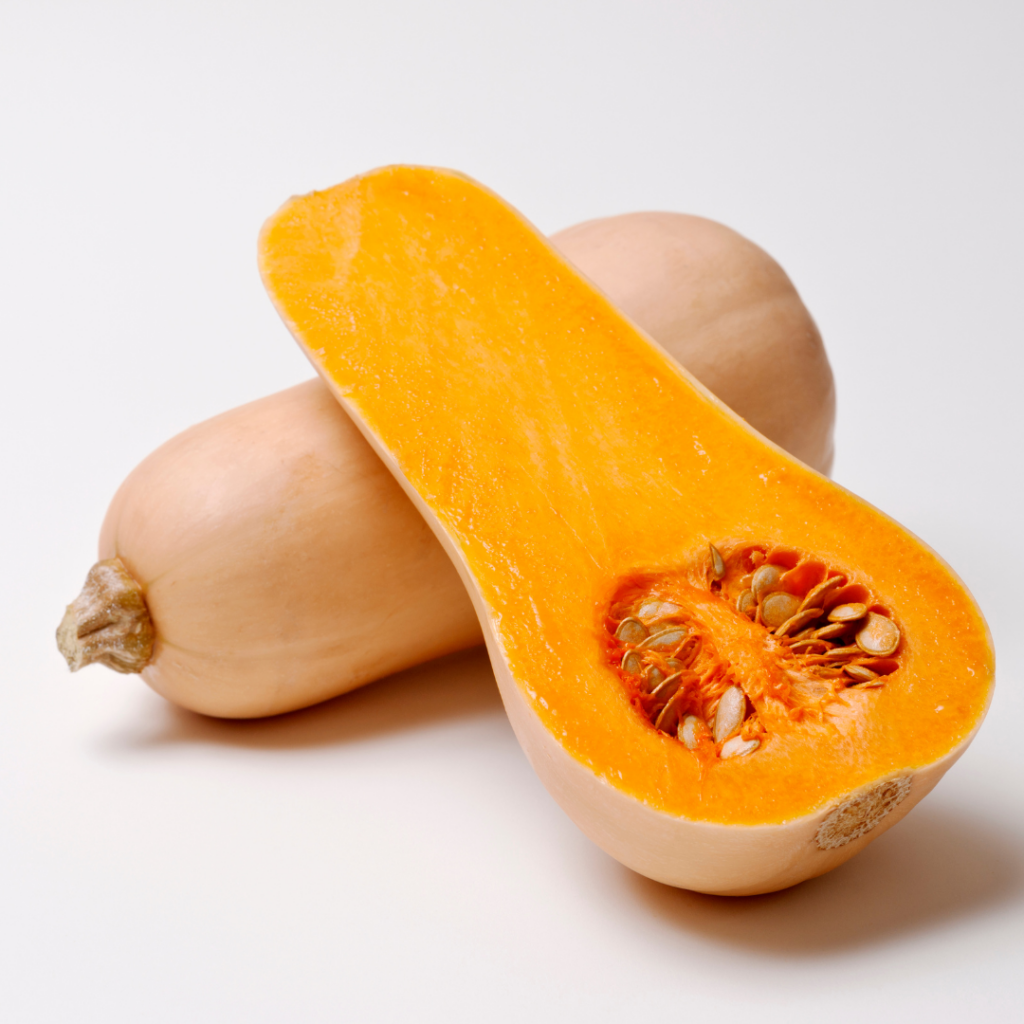
When it comes to butternut squash in particular, there are 4 main things you want to check at the grocery store before buying (1):
1. Weight: Does it feel heavy for its size? Try picking up a few of about the same size, the one that feels heaviest will be more ripe.
2. Hollow: When you tap on the side does it sound hollow? If so, you’ve picked a fresh one!
3. Skin: The outer skin should be a creamy tan color with no green areas, soft spots, or large knicks in the skin. A lighter beige color in one spot is ok (this is where it was laying on the ground), the skin should also have a matte finish (shiny indicates it isn’t ripe), and the surface should be hard (your fingernail shouldn’t be able to puncture it).
4. Stem: Ideally, your squash will still have a stem attached to it, and it should be deep brown in color. If the stem is gone it could indicate that it fell out because the squash is past its optimal point of ripeness. No stem also means that the squash won’t keep as long.
Fun Fact
Fun Fact
Butternut squash is actually a fruit (2)! Even though it has an earthy, almost nutty flavor – it’s considered a fruit like tomatoes and avocados are.
How to store squash before cooking
Whole butternut squash can last between one and three months while being stored in a cool dry place, though the flavor is usually best if eaten within the first month (2, 3, 4). It’s best not to refrigerate it when whole (5).
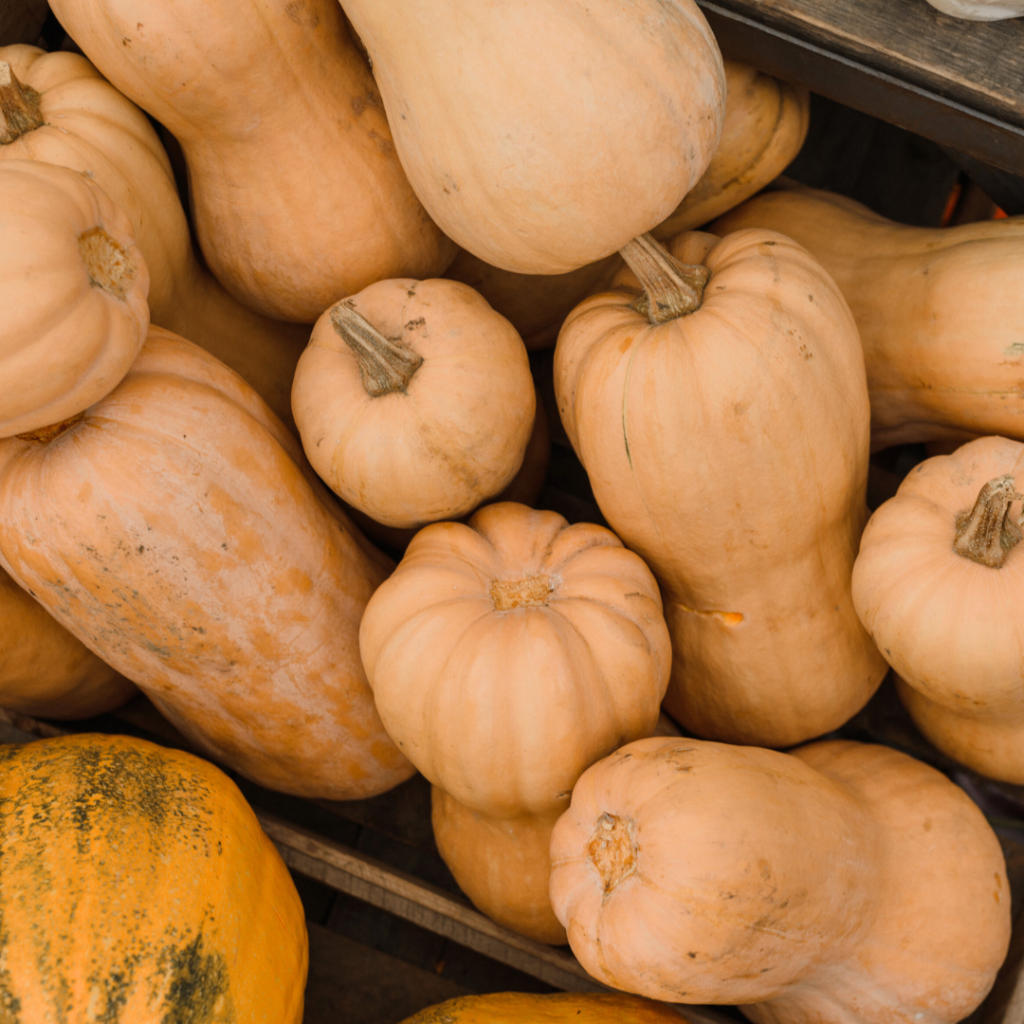
It’s also recommended to keep it away from “ripening fruits” when storing (5). These are fruits like apples, pears, and bananas that let off ethylene gas while ripening which in turn ripens the produce around them.
If the squash has already been peeled but is still uncooked, it can last up to 5 days in the fridge in an airtight container (4).
Watch Andrew & Hannah eat butternut squash!
Watch Andrew & Hannah eat butternut squash!
Andrew is 11 months old and is enjoying butternut squash that was roasted and cut into strips to pick up using his palmar grasp.
Baby Hannah is actually 13 months old in this video – she just graduated to toddlerhood – and she’s eating bite-sized pieces of roasted butternut squash using her pincer grasp.
Spices that pair well with butternut squash
When roasting the squash for your baby, you don’t have to leave it plain – in fact, we’d prefer it if you didn’t!
Babies need to be exposed to a wide variety of textures and flavors when starting solids. Herbs and spices are a great way to do this easily – so get creative and switch it up with the seasonings you use!
We recommend adding oil, like olive or avocado oil, or even butter before you cook butternut squash. This provides a source of healthy fat and can make the squash more creamy when mashed after roasting.
Some spices that we love to add to butternut squash for babies are garlic, onion powder, or paprika.
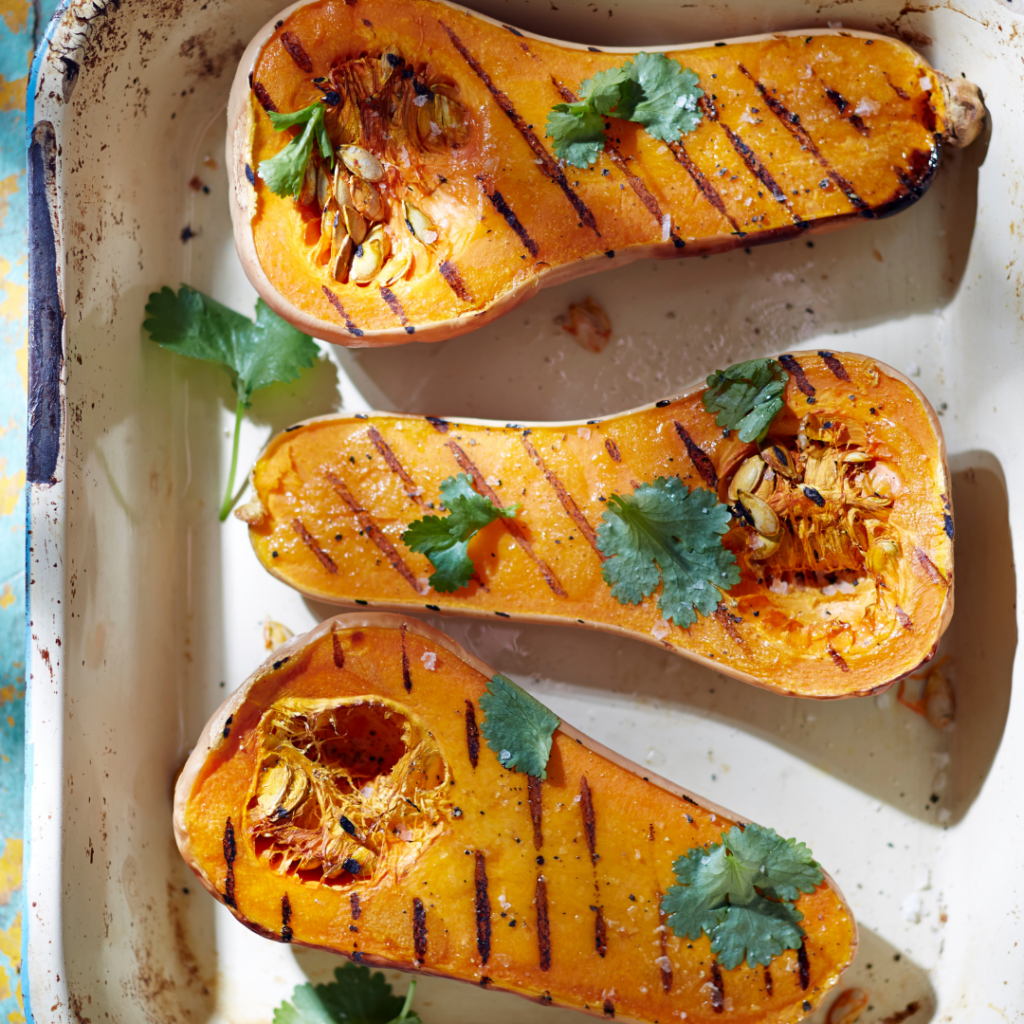
Storing leftover butternut squash for babies
If you have leftover, cooked butternut squash after feeding your baby, store it in an airtight container in the fridge for up to 3-5 days (5). If you have a lot left, it can also be stored in an airtight container in the freezer for up to 6 months (5).
It’s recommended to freeze diced squash on a baking pan first so they don’t stick together and then transfer to an airtight container for longer storage (3).
That said, when storing it in the freezer, it’s actually best to mash or puree it first (3). Then you can put it into an ice cube tray or Souper Cubes for easily portioned amounts. This will keep for three to six months and is a great way to keep squash to repurpose into tasty soup later on (3)!
See our recipe below for inspiration!
Nutritional benefits
Butternut squash is an excellent source of fiber, which is beneficial for gut health and digestion. It can also help prevent constipation when consumed on a more regular basis!
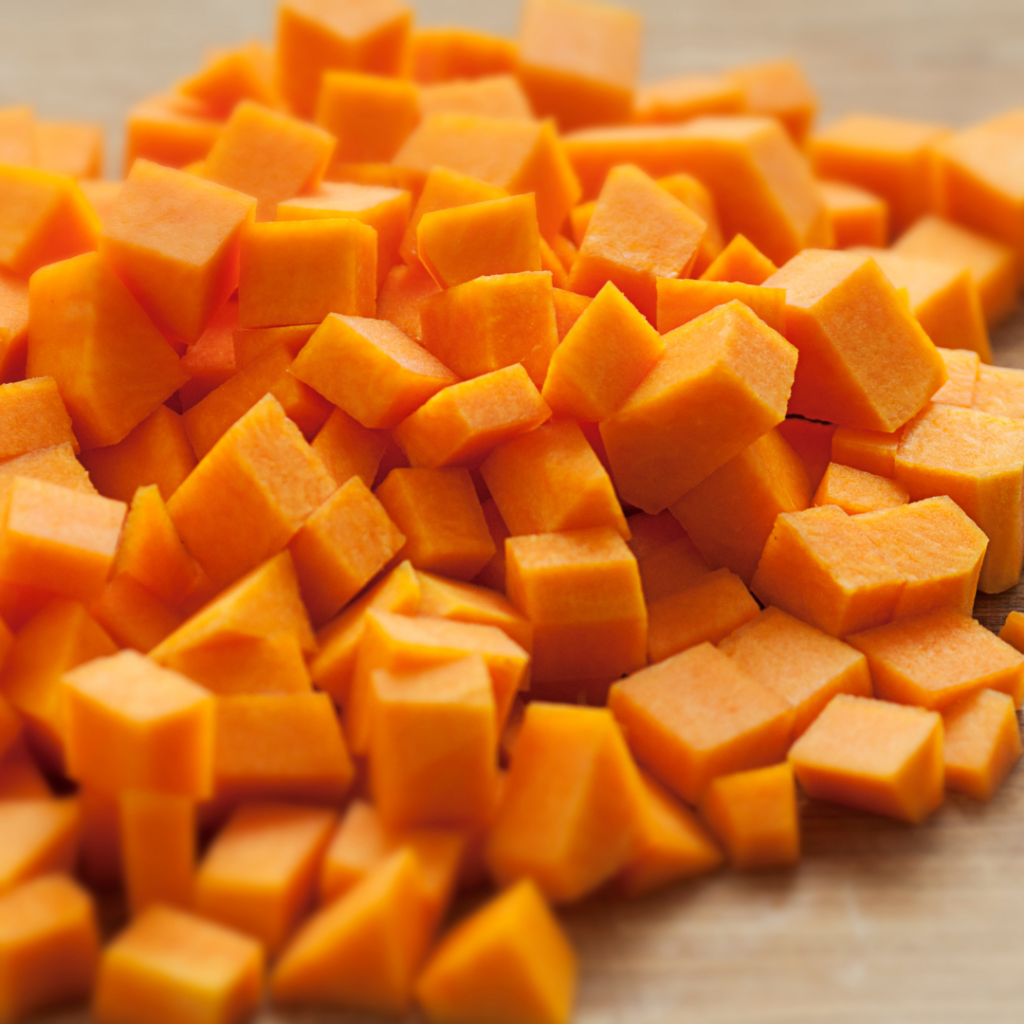
Butternut squash is loaded with other vitamins and minerals including (2):
- Vitamin C for maintaining a healthy immune system and skin health (it’s also a great food to pair with plant-based iron sources to help with iron absorption).
- Vitamin B6 for brain health, immunity, and metabolism functions.
- Magnesium for muscle and nerve function.
- Potassium for proper muscle function and regulation of blood pressure.
Finally, butternut squash is rich in beta-carotene, which is a plant compound that our bodies convert to vitamin A – great for eye and skin health, and functions as an antioxidant (2).
Can babies be allergic to butternut squash?
Butternut squash isn’t considered to be one of the top allergenic foods for babies and can be introduced alongside other non-highly allergenic foods without having to wait (the 2-day wait rule is for top allergens only).
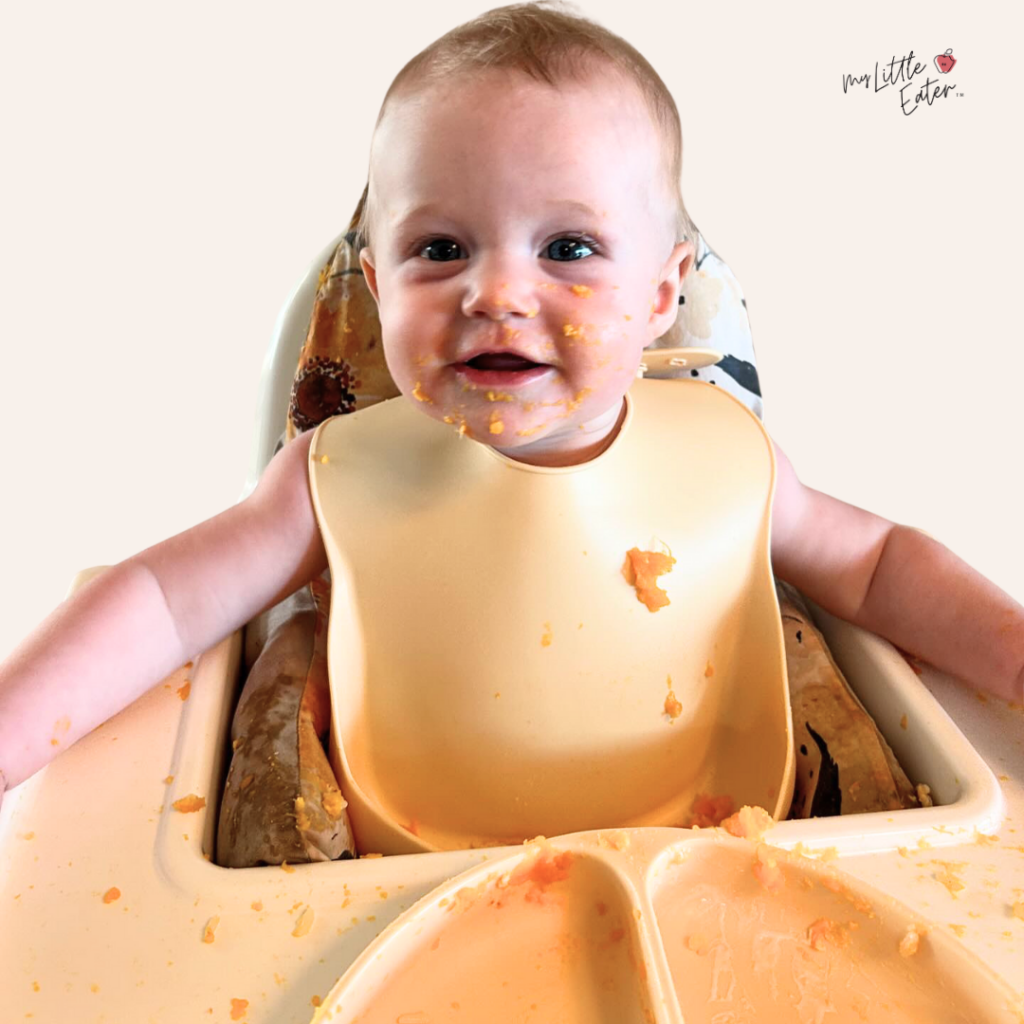
Although uncommon, it is possible to develop contact dermatitis after handling butternut squash, which can cause an itchy rash on your hands (6). Therefore, after handling butternut squash, be sure to wash your hands thoroughly.
To reduce the risk of your baby reacting, wash your baby’s hands and face after eating. Applying a skin barrier, like Vaseline, to your baby’s face before eating can also reduce the risk of them reacting.
To get instant access to all the foods in the Texture Timeline™ Food Video Library, along with our signature course for starting solids with evidence-based research and expert guidance, enroll in our Baby Led Feeding Program!
Complete with video lessons, printable resources for everything along the way, and an app to access it all at your fingertips, it’s like having a team of feeding experts in your pocket supporting you every step of the way.
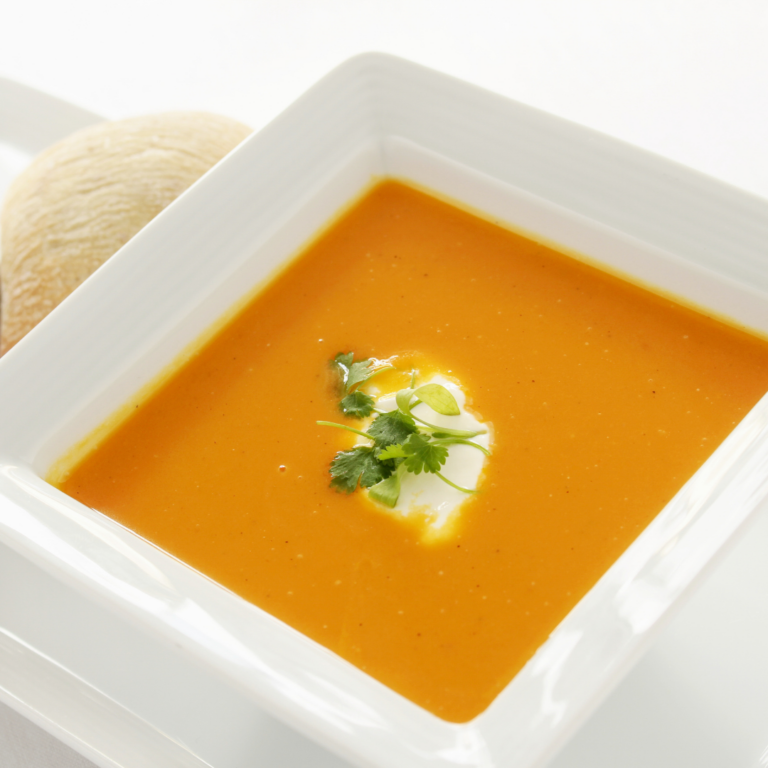
Best butternut squash puree for babies (& soup for the family!)
Equipment
- 1 Pot (large)
- 1 immersion blender
Ingredients
- 1 yellow onion (small, chopped)
- 2 carrots (diced)
- 3 cups butternut squash (peeled, seeds removed, cubed)
- 14 oz. tofu (soft, crumbled)
- 1 cup vegetable broth (low sodium)
- 1 cup coconut milk (or milk/cream of choice)
- 2 tbsp olive oil
- ½ tsp cinnamon
- ½ tsp curry powder
- ¼ tsp nutmeg
- Salt & pepper to taste
Instructions
- In a pot, heat the oil over medium-high heat. Add the carrots, onion, cinnamon, nutmeg, curry powder, salt and pepper. Cook, stirring occasionally, for about 5 minutes.
- Add the cubed squash, vegetable broth, and coconut milk. Simmer and cook until all of the vegetables are soft. Stir occasionally to keep anything from sticking to the pot, and keep a close eye on it because the milk can bubble over easily. Add the tofu last.
- Use an immersion blender to make the butternut squash puree (or soup). Remove from heat before blending and continue blending until the desired consistency is reached.
- For soup, you'll likely want a smooth, creamy texture. This is a thicker soup but you could add more broth or coconut milk to thin it out (it will affect the rich flavor though).
- For a butternut squash puree (phase 1), you can finish blending earlier to reach a phase 1 texture with some small lumps and bumps. Remove a portion for your baby and continue blending to reach the smooth texture of soup, if desired.
- If your baby is on phase 0, continue blending until you reach the smooth consistency of soup. Take a portion out for your baby, add 1-2 tbsp more of coconut milk, and blend again to thin it out even more.
Notes
Was this helpful? Pin it for later!
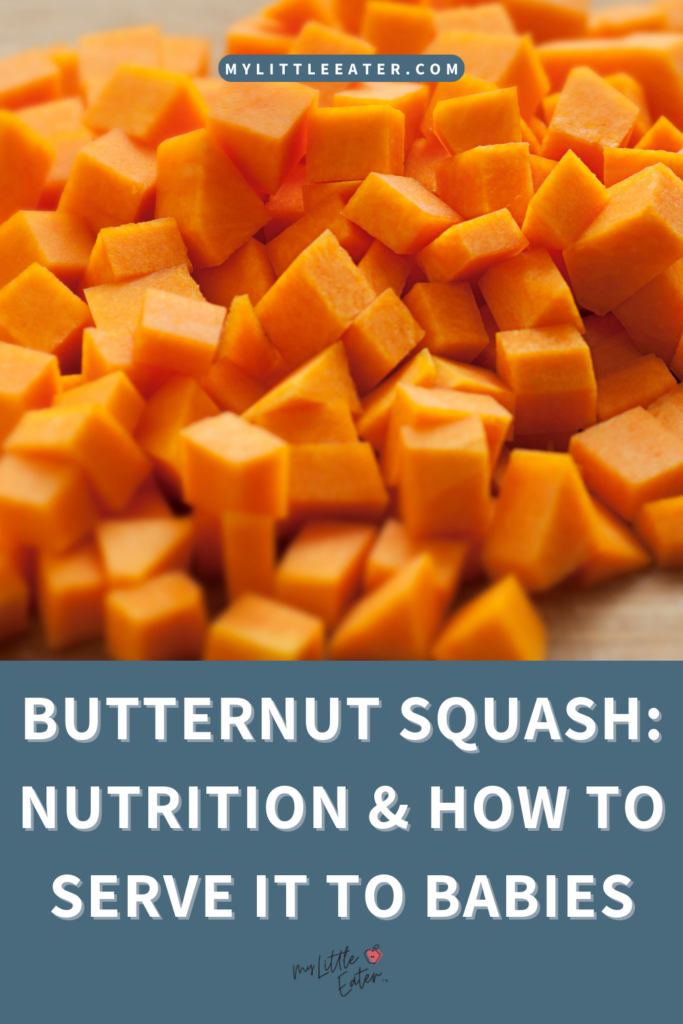
References
- https://www.tasteofhome.com/article/pick-best-butternut-squash-thats-perfectly-ripe/
- Harvard T.H. Chan. School of Public Health. The Nutrition Source: Winter Squash. https://www.hsph.harvard.edu/nutritionsource/food-features/winter-squash/
- https://food52.com/blog/25531-how-to-store-butternut-squash
- https://www.dailyharvestexpress.com/5-facts-about-butternut-squash/
- https://www.allrecipes.com/how-to-store-butternut-squash-7814216
- Shah, M. A., & Feldman, S. R. Hand Dermatitis Secondary to Exposure to Butternut Squash. Case Reports in Dermatology, 14, 123-126, 2022.

Chelsey Landry, RD
Community Dietitian at My Little Eater Inc., and bunny-mom to Hickory. Chelsey offers one-on-one counselling to parents of babies and toddlers that need more customized support. Learn more by booking a free discovery call with her today!

Chelsey Landry, RD
Community Dietitian at My Little Eater Inc., and bunny-mom to Hickory. Chelsey offers one-on-one counselling to parents of babies and toddlers that need more customized support. Learn more by booking a free discovery call with her today!
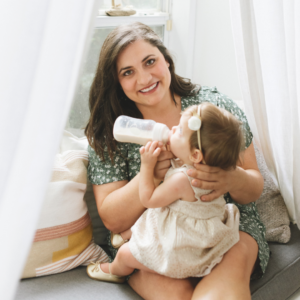
Mallory Roberts, SLP
Mallory is a Speech-Language Pathologist, Infant Feeding Specialist, and Craniosacral Therapist. She's also a busy mom of four little ones!

Mallory Roberts, SLP
Mallory is a Speech-Language Pathologist, Infant Feeding Specialist, and Craniosacral Therapist. She's also a busy mom of four little ones!
